|
The concept has escaped many of us over the years. Sometimes you can get by with what you have. If you don't have what you need, maybe you can just figure something out. It has been a trying year at our house—the kind that makes you think. November of last year started with a serious health problem that required a dangerous surgery and prolonged recovery period for Rosie. Later, we lost her brother and his wife within a seven week period. We started to wonder about the things we have, the things we need, and the things that can be passed on or discarded. Where are we headed with the remainder of our lives? We weren't the only ones. In October Rosie received a call from her remaining, brother. He wanted to give us an old family shotgun. He knew we had a son and grandsons to pass it to and it was important to keep it in the family. He asked us to stop by their house and pick it up when we came up to Kansas City for our sister-in-law's service's. As it turns out, we got more than a shotgun. We also received a handmade heirloom and an important reminder of earlier days when people made do with what they had. The Gun. The gun is a Savage Arms, Stevens Model 77D. A date stamp at the aft end of the barrel shows a year-code K, indicating it was manufactured in about 1959. This was only a few years after Rosie's parents, Charlie and Pearl, moved into town from the farm. The gun isn't one of the fancy 'sporting' shotguns with the elaborate engraving and checkered grips that many expect with their guns these days. This old Stevens was a tool that was used to put food on the family table. It has a long, full-choke barrel and it is in good condition. There are some stock dings but the blued metal parts look very good for a gun approaching it's 60th year. Guns like this could reach flying water fowl; they could also take a squirrel out of the top of a tree; or a rabbit at a fairly long shotgun range. But you had to let a quail fly for a moment to avoid obliteration. Today, many folks get queasy at the thought of eating wild game. Others, for whatever reasons, oppose hunting altogether. In the days when we grew up game was a meat staple on many tables. Not just because people liked it, but because it was an economic necessity. The meat on the table came at the cost of a shot-shell or two and money was scarce. Much of the shot fell out of the meat during preparation and cooking. Then, you simply chewed lightly, removed the uningested shot from your mouth and placed it on the side of your plate. After the meal, it was scraped into the trash with other scraps. You didn't have to worry about damaging the garbage disposal—there wasn't one. As the family sons grew older, the necessity of hunting transitioned to sport hunting for all of them. It was then that some of them bought the nicer checkered and engraved firearms. But this old Model 77D stayed put with the family for years. 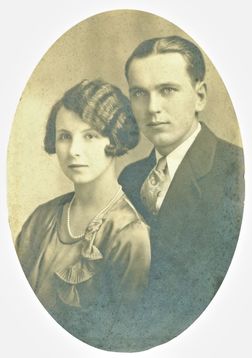 Charlie and Pearl - February 1928 Charlie and Pearl - February 1928 The Times. With the above said, let me say something about the family and the time it was formed. It leads directly to the next subject. Charlie and Pearl were married in February of 1928—about a year before the start of the Great Depression. Like many families of the day, their grandparents were settlers and some were immigrants. They were working people of modest means who made a good life with what they had or could find. But the realities that Charles and Pearl faced quickly were the tough times that came with the depression. Raising families today is daunting for a lot of young couples. But they cannot imagine the hardships that many faced in the 30's when jobs, money, fuel and food were in painfully short supply. With a large household, figuring things out and making do with what they had were part of surviving. The Bonus—A Hand-Made Cleaning Rod. After the shotgun, my brother-in-law gave me the cleaning rod. I'm sure there was a little grin on his face. He knew it was special. The 35" long rod was hand made from what appears to be red oak. I am a woodworker and I suspect the tools used to make it were: pocket knife, saw, sandpaper, brace & bit and a small wood chisel (or one of the small sharpened screwdrivers that were stored in coffee cans in the family garage). The rod (below) is about 1/2" in diameter, but is slightly oval-shaped in places. Both ends are flattened very smoothly. The cleaning end is flattened to 5/16", has a 1"x 3/16" slot, and the ends of the slot were likely chiseled square. The other end is flattened to 3/8" and has a small hole, probably meant for hanging. The hanging end flares out to about 5/8" wide and the flat surfaces blend smoothly into the shaft. There is a wide strip of tape about 1/3 of the way from the cleaning end. The Tape is a mystery—it might be a repair or the rod might be made from two pieces of re-purposed wood. The varnish coating and age have given the fabric tape a plastic-like consistency. I said "re-purposed" for a reason. The slotted, cleaning end has two small holes, about the size of an 18 or 20 gauge nail, and they go all the way through. The hanging end also has what looks like the path of a nail near the hanging hole. I suspect the rod came from the garage scrap pile that held pieces of lumber from earlier projects or disassembled objects. You didn't throw good stuff away. A piece of wood was selected, cut to width, whittled and sanded to shape and tooled at each end. There was no need to fill the holes—it, too, was just a tool. As I was driving home that weekend and thinking about the rod, the term "folk art" came to mind. When we got home, a quick Google search led to someone else had a similar rod and thought [1]. Later, I got a gun cleaning kit out of the cabinet and took it and the shotgun to the deck to lubricate the action and apply a light coat of oil. I looked down the barrel and it was very clean inside, but I wanted to put a protective coat in there too. I took the metal cleaning rod and a patch out of the kit. Then I paused, and put the modern rod back into the box. I threaded the patch into the slot in my new treasure and It worked like a charm. With the gun in the gun safe, I found a couple of hooks and hung the wooden rod on our dining room wall. That is where an heirloom belongs. 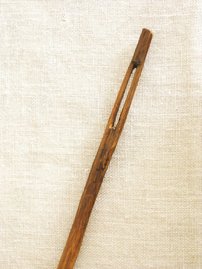 Note: 1. Folk Art? I noted above that I did a Google search for wooden, handmade gun cleaning rods. I found this one on an auction site. I think the price was about $50 and they were selling it as: "Vintage, Folk Art Gun Cleaning Rod, Handmade, Primitive, Rifle Cleaner, Wood Shaft, Gun Collectible ..." Ours is a lot nicer looking and it ain't for sale. We recently received an original copy of the composite class photo for the St. Francis High School Class of 1932. The copy was pretty heavily damaged [1], with tears through some of the portraits and one photo was about 1/4 gone. But as we looked we saw that several photos were intact. Others could be cleaned up with a little editing. We also knew that some of these salvageable pictures had family connections with the members of our "The Catholic Osage Mission" Facebook page or other area Facebook Groups. We cropped and cleaned up some of them and researched a little information about the later life of the graduates. (The first one was pretty easy.) Here they are (All can be enlarged with a click): 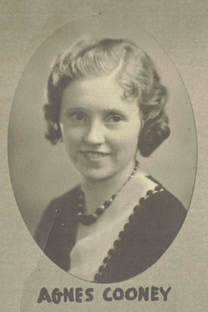 Agnes "Ag" Cooney Brogan. Ag was born on October 12, 1913, and married my father Lawrence E. "Bob" Brogan on July 5 of 1945 at St. Francis Catholic Church, St. Paul. After World War II, they lived in Wichita for a few years before returning to St. Paul. Her grandfather, Charles C. Cooney was one of Osage Mission (St. Paul's) earliest settlers and businessmen. Her father Charles J. Cooney worked at the family carriage factory; and later operated a hardware and a grocery store in St. Paul. Ag and Bob, along with Chuck and Magdalene Norris, continued the grocery tradition with stores in Erie and St. Paul. 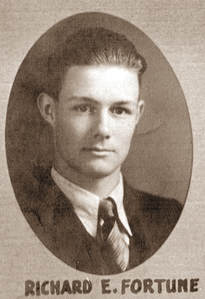 Richard "Dick" Fortune. Dick was born September 6, 1912, in Las Vegas New Mexico. At age 2, he moved with his family to a farm northwest of St. Paul and he attended Hilton Grade School. He and Cornelia Elsenratt were married in 1947. Dick was a farmer and stockman for forty-five years retiring from farming in 1976 and he sold his herd in 1991. 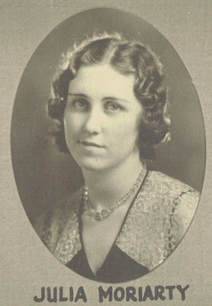 Julia "Jude" Moriarty. After graduating from St. Francis, Julia moved to Wichita where she met and married James Joseph Oates. Jude and James had five children: Maureen Oates Kearney, Michael J. Oates, Jim Oates, Terry Oates and Sarah Randolph. Many in St Paul remember her son Jim Oates who graduated with the class of the SPHS class of 1968. 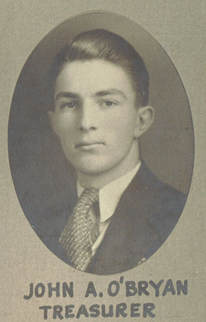 John A. O'Bryan. John was the eleventh, and last, child born to Mr. & Mrs. William Wuytz & Grace Emily O'Bryan, Sr. He graduated from St. Benedict's (now Benedictine) College, Atchison, in 1936. On returning to St. Paul from Atchison, he worked for his father for a while and was later involved with several business ventures in Parsons, Bentonville-Rogers, Arkansas, and Texas. He eventually returned to southeast Kansas. He married Helen Weingart in 1938 and they had eleven children. Helen passed in May of 1970 and John married Gene Ella Washburn in May of 1971. 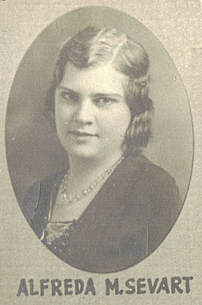 Alfreda M. Sevart. Alfreda was the second child of Henry & Cecelia (Richard) Sevart. On Nov 7 1933 she married Jim Purdon at St Francis Church. They settled in the Greenbush community. Nine children were born to this blessed union. The 6 youngest graduated from SPHS...Harold 1957, Charles Bernard (Bun) 1959, Kate 1961, Frank 1963, Barbara 1964 and Mary 1966. She was kept busy as a mother, farm wife, gardener and great cook. Alfreda passed away Jan 1, 1977. 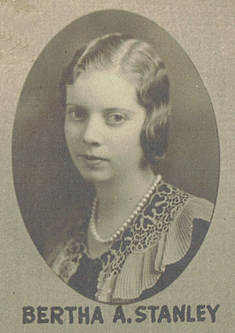 Bertha A. Stanley Coomes. Bertha "Midge" Stanley was born on July 11, 1912. She attended school in St. Paul. On December 26, 1933, Bertha married Adrian Joseph Coomes at St. Joseph's Catholic Church, South Mound, Kansas. In 1942, Adrian and Bertha bought a farm a few miles south of St. Francis Catholic Church which they farmed until 1955. Midge was active with Home Demonstration. She enjoyed gardening and her laying hens. 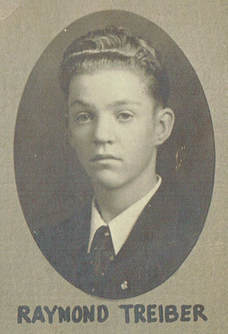 Raymond "Ray" Treiber. Ray was born on November 1, 1913, at Baxter Springs, Kansas. At age 7 he moved to rural St. Paul with his family. He married Dorothy L. Johnson in September of 1937. He worked for the Katy Railroad and the Kansas Army Ammunition Plant; but many of us remember him as the custodian of our schools. Many here, and at other locations, call Ray "Dad" or "Grandpa." 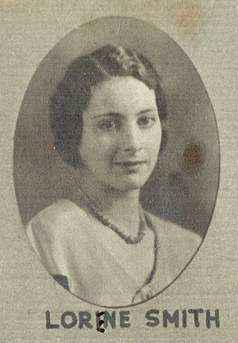 Lorene Smith VanLeeuwen. Lorene is one of our town's brightest stars; and she is among our best sources for community history. She has assisted teachers and students with her vision of a century of rural and city life around St. Paul. Lorene married Andy VanLeeuwen in 1936 and they raised their three sons on a farm north of St. Paul. Lorene and Andy moved into St. Paul in 1985. Andy passed in July of 1990. In addition to being a farm wife and mother, she was the secretary for St. Paul's schools for several years. Lorene resides at the Prairie Mission Retirement Village in St. Paul where she stays current with world, community and village events. 1. The Composite. As noted above, the class composite we received was pretty heavily damaged. Several of the photos were beyond repair but you can enlarge the full image below by clicking on it.
|
Thoughts 'n ThingsSome 'Thoughts' and short articles about past and present-day St. Paul and the Southern Kansas - 4 State Region. Archives
December 2023
Categories
All
|
- Home
-
Our Story
- 1. The Stage is Set
- 2. The Osages Enter Kansas.
- 3. Earliest Commerce
- 4. Earliest Protestant Missions
- 5. The Catholic Osage Mission >
- 6. Progress and Tragedy
- 7. The Missionary Trails >
- 8. A Dangerous Balance - The Civil War >
- 9. The Osage Leave Kansas >
- 10. A Very Unique Community is Born >
- 11. Regional Boarding Schools >
- 12. Transitions
- 13. The Passionists Era Begins
- 14. Citizen Lawmen - The A.H.T.A. >
- 15. The Passionist Influence is Expanded
- 16. The Schools Today >
-
Characters
- The Osages
-
The Missionaries
>
- Father John Schoenmakers >
- Fr. John Bax >
- Mother Bridget Hayden
-
Fr. Paul Ponziglione
>
-
Father Paul's Memoir
>
-
Index - Father Paul's Memoir
>
- Dedication & Introduction
- IX. Construction & Acceptance of Mission Buildings.
- X. Fr. Schoenmakers Arrives at Osage Mission
- XI. Miss Lucille St. Pierre Came to the Neosho
- XII. Progress of the Schools
- XIII. Origin and Development of the Roman Catholic Church in Kansas
- XXVII - Winds of War
- XXVIII — Fr. Schoenmakers Return
- Chapter XLII - Farming Issues, Death Of Father Colleton
- Chapter XLIX - Includes The Death of Fr. Schoenmakers
- Chapter L — Dedication of the New Church
- Conclusion
- Appendix I — Copy of a letter to Sister M. Coaina Mongrain about the coming of the Sisters of Loretto at Osage Mission
- Appendix 6 — A Sketch of my Biography
- Appendix 7 - Letter to W. W. Graves
-
Index - Father Paul's Memoir
>
-
Father Paul's Memoir
>
- Father Philip Colleton
- Brother John Sheehan
- W. W. Graves
- 17 Sisters
- 17 Sisters II - Fr. Fox's Sermon
-
Who's Behind the Window
>
- Who We Were 120 Years Ago
- 1. The Thomas Carroll Window
- 2. The W.W. O'Bryan Window
- 3. The Jas. Owens & Family Window
- 4. The C.P & C.J. Hentzen Windows
- 5. The Dr. McNamara & Family Window
- 6. The Fitzsimmons & Family Window
- 7. The Parents of T.K. Joyce Window
- 8. J.E. Sevart & Family Window
- 9. The Rev. John Schoenmakers S.J. Window
- 10. The Patrick Diskin and L&M George Window
- 11. The J.A. Johnston & Family Window
- 12. The Peter & Jacob Bonifas Windows
- 13. The Mr & Mrs. Patrick Keeting Window
- 14. The John Butler Window
- 15. The Mr. & Mrs. Gutting Window
- 16. Rosette Window Above Doors
- 17. The Michael A. Barnes Window
- 18. The Henry M. O'Bryan Window
- 19. The John and Bridget McCarthy Window
- The Sodality Windows
- The Church Women's Bonfire (Graves)
- Beechwood
- John and Margaret Naudier
- Fr. Tom McKernan - The Poet Priest of Kansas
- The Dimond Family and Estate Sale
- Dear Sister >
- A Year and a Day — Passionist Memories.
- Mary Elizabeth Lease
- K of C Council 760 - The Early Days
- Our Hometown Boys
- SPHS Class of 1956
-
Places
- The Great American Desert
- St. Francis Catholic Church
- St. Francis de Heironymo Catholic Church Grounds
- St. Paul - 135 Years Ago
- St. Paul - 1890's as a Scale Model.
- St. Paul - The Booming 60's
- Osage Mission as a Statewide History Finalist
- St. Francis Cemetery
- Hope Cemetery
- The Basement Chapel
- World War I Museum Display
- St. Paul Middle School >
- Ladore
- St. Boniface, Scipio KS
- Road Trip - Father Emil Kapaun
- Exchange State Bank Robbery!
- Thoughts ...
- Links
- Link Page
Thoughts 'n Things
Past and Present Day St. Paul, Southern Kansas and The Four - State Region.

|
acatholicmission.org is a privately hosted website. We hope that our site will educate and entertain those who are interested in the fascinating Osage Mission - St. Paul - Neosho County Kansas story. Ours is a regional story that crosses state lines, ethnic groups, faiths and a variety of frontier and post-frontier interests. Enjoy.
acatholicmission.org Copyright © 2016 - 2024. All rights reserved. (See copyright note on Contact page.) |





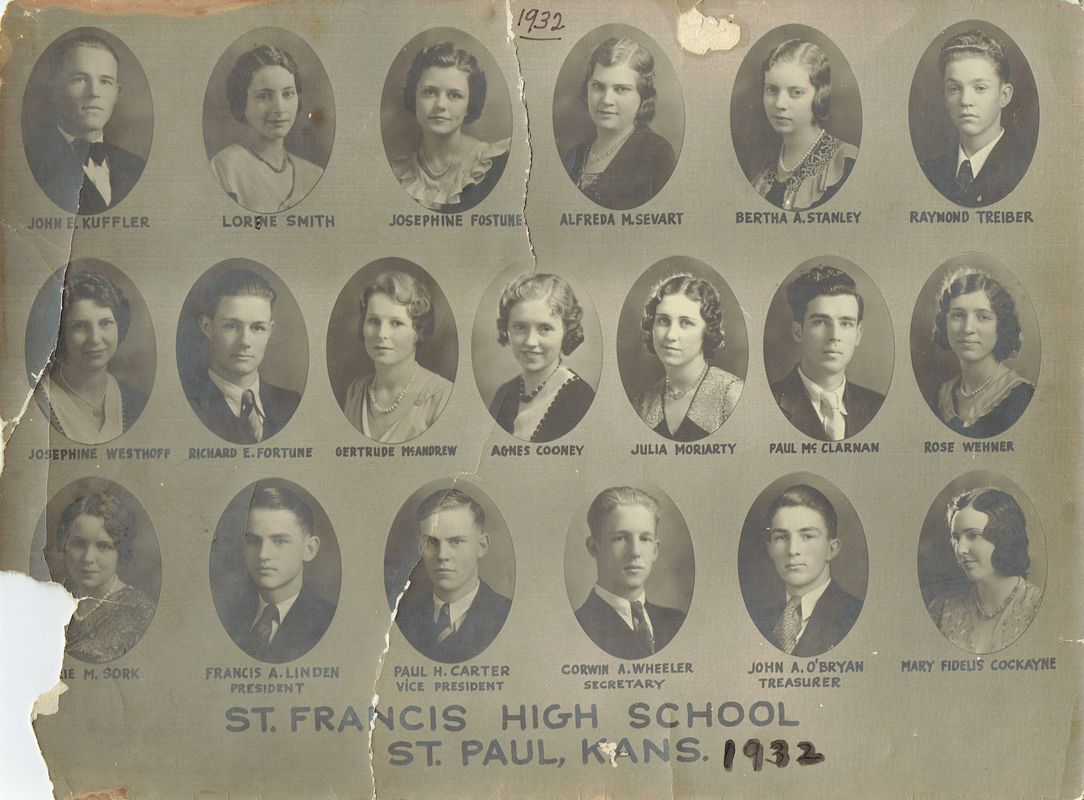
 RSS Feed
RSS Feed